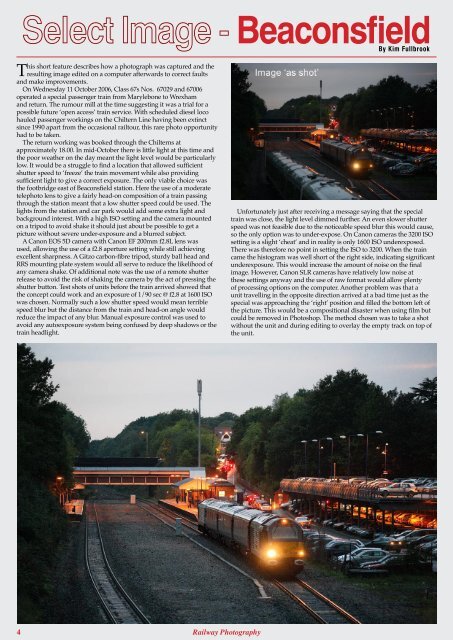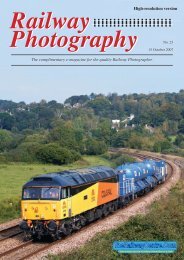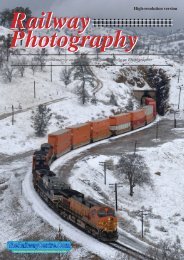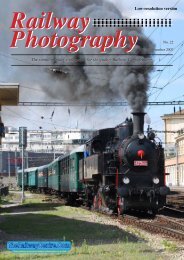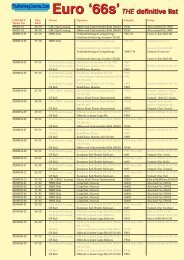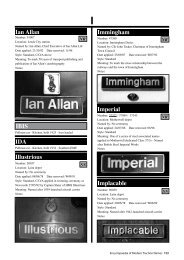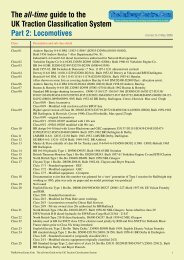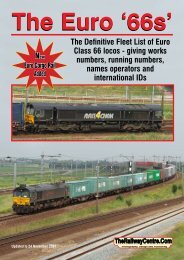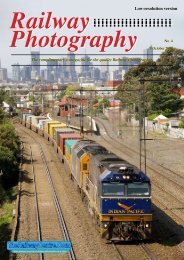Download High Resolution file 6mb - The Railway Centre.Com
Download High Resolution file 6mb - The Railway Centre.Com
Download High Resolution file 6mb - The Railway Centre.Com
- No tags were found...
Create successful ePaper yourself
Turn your PDF publications into a flip-book with our unique Google optimized e-Paper software.
Select Image - BeaconsfieldBy Kim FullbrookThis short feature describes how a photograph was captured and theresulting image edited on a computer afterwards to correct faultsand make improvements.On Wednesday 11 October 2006, Class 67s Nos. 67029 and 67006operated a special passenger train from Marylebone to Wrexhamand return. <strong>The</strong> rumour mill at the time suggesting it was a trial for apossible future ‘open access’ train service. With scheduled diesel locohauled passenger workings on the Chiltern Line having been extinctsince 1990 apart from the occasional railtour, this rare photo opportunityhad to be taken.<strong>The</strong> return working was booked through the Chilterns atapproximately 18.00. In mid-October there is little light at this time andthe poor weather on the day meant the light level would be particularlylow. It would be a struggle to find a location that allowed sufficientshutter speed to ‘freeze’ the train movement while also providingsufficient light to give a correct exposure. <strong>The</strong> only viable choice wasthe footbridge east of Beaconsfield station. Here the use of a moderatetelephoto lens to give a fairly head-on composition of a train passingthrough the station meant that a low shutter speed could be used. <strong>The</strong>lights from the station and car park would add some extra light andbackground interest. With a high ISO setting and the camera mountedon a tripod to avoid shake it should just about be possible to get apicture without severe under-exposure and a blurred subject.A Canon EOS 5D camera with Canon EF 200mm f2.8L lens wasused, allowing the use of a f2.8 aperture setting while still achievingexcellent sharpness. A Gitzo carbon-fibre tripod, sturdy ball head andRRS mounting plate system would all serve to reduce the likelihood ofany camera shake. Of additional note was the use of a remote shutterrelease to avoid the risk of shaking the camera by the act of pressing theshutter button. Test shots of units before the train arrived showed thatthe concept could work and an exposure of 1/90 sec @ f2.8 at 1600 ISOwas chosen. Normally such a low shutter speed would mean terriblespeed blur but the distance from the train and head-on angle wouldreduce the impact of any blur. Manual exposure control was used toavoid any autoexposure system being confused by deep shadows or thetrain headlight.Unfortunately just after receiving a message saying that the specialtrain was close, the light level dimmed further. An even slower shutterspeed was not feasible due to the noticeable speed blur this would cause,so the only option was to under-expose. On Canon cameras the 3200 ISOsetting is a slight ‘cheat’ and in reality is only 1600 ISO underexposed.<strong>The</strong>re was therefore no point in setting the ISO to 3200. When the traincame the histogram was well short of the right side, indicating significantunderexposure. This would increase the amount of noise on the finalimage. However, Canon SLR cameras have relatively low noise atthese settings anyway and the use of raw format would allow plentyof processing options on the computer. Another problem was that aunit travelling in the opposite direction arrived at a bad time just as thespecial was approaching the ‘right’ position and filled the bottom left ofthe picture. This would be a compositional disaster when using film butcould be removed in Photoshop. <strong>The</strong> method chosen was to take a shotwithout the unit and during editing to overlay the empty track on top ofthe unit.4<strong>Railway</strong> Photography


